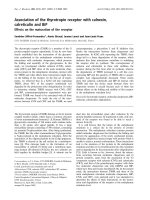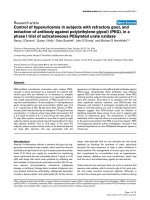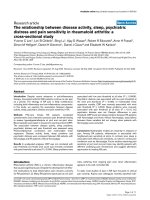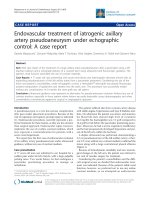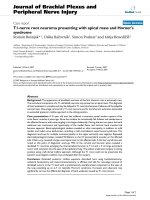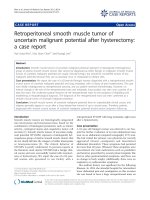Báo cáo y học: " Paediatric Behçet’s disease presenting with recurrent papillitis and episcleritis: a case repor" ppt
Bạn đang xem bản rút gọn của tài liệu. Xem và tải ngay bản đầy đủ của tài liệu tại đây (713.52 KB, 3 trang )
CAS E REP O R T Open Access
Paediatric Behçet’s disease presenting with
recurrent papillitis and episcleritis: a case report
Fulvio Parentin
1*
, Loredana Lepore
2
, Ingrid Rabach
2
, Stefano Pensiero
1
Abstract
Introduction: Behçet’s disease is a chronic multisystem vasculitis characterized by mucocutaneous, articular,
neurological, gastrointestinal and ophthalmological lesions. Ocular involvement is mainly represented by recurrent
uveitis, especially posterior uveitis; however, iridocyclitis, retinal and choroidal vasculitis, optic neuritis and retinal
vascular occlusion can also occur.
Case presentation: A 12-year-old Caucasian boy with a history of recurrent buccal aphthosis and nonspecific
gastrointestinal symptoms was admitted to our hospital with blurred vision associated with acute episcleritis and
papillitis. The patient’s pathergy test was positive, suggesting a diagnosis of Behçet’s disease. Corticosteroid and
cyclosporine therapy was started, but further episodes were noted in both eyes. The patient was then switched to
intravenous infliximab, with complete resolution of the inflammation after the second infusion.
Conclusion: Episcleritis and papillitis should be added to the list of uncommon manifestations of pediatric Behçet’s
disease. Infliximab is an effective, new therapeutic approach for Behçet’s disease that is refractory to the
conventional corticosteroid and immunosuppressive therapy.
Introduction
Behçet’s disease is a chronic multisystem vasculitis char-
acterized by mucocutaneous, articular, neurolo gical, gas-
trointestinal and opht halmological lesions [1]. The
hallmark of ocular involvement is recurrent uveitis,
especially posterior uveitis; however, i ridocyclitis, retinal
and choroidal vasculitis, optic neuritis and retinal vascu-
lar occlusion can also occur [2]. Other ocular manifesta-
tions, such as scleritis, are very unusual and are
described only among adult patients [3,4]. We report an
exceedingly rare manifestation of childhood-onset Beh-
çet’ s disease occurring together with recurrent and
simultaneous episcleritis and papillitis.
Case presentation
A 12-year-old Caucasian boy was admitted with painful
redness in the conjunctiva and acutely blurred vision in
his right eye. He referred a history of recurren t buccal
aphthosis and nonspecific gastrointestinal symptoms,
such as abdominal pain and diarrhea. At admission,
decreased visual acuity in the right eye (20/200) was
observed. A slit lamp examination showed d iffuse and
painful episcleritis with injection in the superficial
episcleral vessels (Figure 1); the fundus examination
revealed a right hyperemic disc with blurred margins
(Figures 2 and 3). Inflammat ory markers were increased
(erythrocyte sedimentation rate, 31 mm/1 h; C-reactive
protein, 0.7 mg/ L). The laboratory tests for infectious
diseases, C3 and C4, rheumatoid factor, anti-double-
stranded DNA (dsDNA) and anti-Smith antigen anti-
neutrophil cytoplasmic antibodies were negative. Human
leukocyte antigen typing was negative for B51, showing
A02, A68, B44, B39, DRB1 and DRB3. A pathergy test,
performed using an intradermal 21-gauge needle punc-
ture on the skin of the forearm, was positive. According
to the criteria of the International Study Group for Beh-
çet’s Disease, we diagnosed right optic neuritis and epi-
scleritis secondary to Behçet’ s disease and commenced
corticosteroid therapy with oral prednisone 1 mg/kg and
dexamet hasone eyedrops six times daily in the right eye.
The patient’s fundal and conjunctival appearance
returned to normal within one week, with his visual
acuity returning to 20/20. Therapy was therefore
stopped. After this initial manifestation, the disease
* Correspondence:
1
Department of Surgery, Ophthalmology Unit, Institute for Maternal and
Child Health Burlo Garofolo, Via dell’Istria, 65/1, Trieste I-34100, Italy
Full list of author information is available at the end of the article
Parentin et al. Journal of Medical Case Reports 2011, 5:81
/>JOURNAL OF MEDICAL
CASE REPORTS
© 2011 Parentin et al; licensee BioMed Central Ltd. This is an Open Access article distributed under the term s of the Creative Commons
Attribution Lice nse ( which permits unrestricted use, distribution, and reproduction in
any medium, provided the original work is properly cited.
relapsed four times in the fo llowing six months in both
eyes. The patient was therefore commenced on oral
cyclosporine 100 mg twice daily, but another two epi-
sodes were n oted, and the therapy was stopped after
four mo nths. He was then switched to endoveno us
infliximab, a chi meric anti-tumor necrosis factor-a
(anti-TNF-a) monoclonal antibody, in an attempt to
control the disease. Infusions of 5 mg/kg infliximab
were administered at zero, two and six weeks and then
at intervals of eight weeks. There was a remarkable
response soon after the first infusion and a complete
resolution of the inflammation after the second infusion.
The patient remains well one year later and continues
to enjoy remission on continued therapy with infliximab
at intervals of eight weeks.
Discussion
Childhood-onset Behçet’ sdiseaseisuncommon,
accounting for 3% to 7% of all cases [2]. Scleritis may be
a harbinger of systemic autoimmune inflammatory dis-
eases. Few publications have reported an association
between Behçet’s disease and scleral inflammation, and
only among adult patients .Episcleritisisabenign
inflammation confined to the episcleral tissue; patients
with episcler itis usually complain of mild pain. In 2004,
Dursun et al. [3] reported a case of systemic Behçet’ s
disease with anterior necrotizing scleritis, lateral rectus
myositis and recurrent retrobulbar optic neuritis. Nodu-
lar and diffuse scleritis is characterized by edema and
injection in both the superficial and deep episcl eral ves-
sels, and pain is usually severe and deep-seated. Finally,
scleromalacia perforans is a necrotizing scleritis, rela-
tively asymptomatic and without inflammation. In 2005
Sakellariou et al. [4] reported the unique association
between Behçet’s disease and scleromalacia perforans.
Optic neuritis is a rare mani festation of neuro-Beh-
çhet’ s disease. A search of MEDLINE retrieved only one
case report of inflammatory optic nerve involvement in
the pediatric age group [5]. The diagnosis in children is
difficult, as the disease is uncommon and clinically
resembles other diseases, such as multiple sclerosis.
Another important differential diagnosis is central
venous sinus thrombosis, which is well described in
Behçet’s disease and is usually characterized by severe
headache and deterioration in general condition.
Infliximab, a chimeric monoclonal antibody to TNF-a,
was developed and used to treat systemic inflammatory
disorders such as rheumatoid arthritis and Crohn’sdis-
ease. Proinflammatory cytokines, including TNF-a,are
Figure 1 Diffuse right episcleritis with injection in the
superficial episcleral vessels.
Figure 2 Hyperemic optic disc with blurred margins (color
fundus photograph).
Figure 3 Hyperemic optic disc with blurred margins (red-free
fundus photograph).
Parentin et al. Journal of Medical Case Reports 2011, 5:81
/>Page 2 of 3
known to be elevated in active Behçet’s dis ease, suggest-
ing that anti-TNF-a therapy might be effective. Clini-
cally, significant improvement of various Behçet’ s
disease manifestations with infliximab therapy has been
reported in the literature [6,7]. A recent study demon-
strated that the effectiveness o f infliximab on the ocular
inflammation in Behçet’ s disease correlates with the
infliximab serum concentrations [8].
Conclusion
First, our report underlines that episcleritis and papillitis
without uveitis should be added to the list of uncom-
mon manifestations of pediatric Behçet’ s disease . Sec-
ond, infliximab seems to be an effective drug for the
mana gement of Behçet’s disease that is refractory to the
conventional corticosteroid and immunosuppressive
therapy. The selection of optimal dose and frequency of
infusion required standardization for our patient.
Informed consent
Written informed consent was obtained from the
patient’ s legal guardian for publication of this case
report and accompanying images. A copy of the written
consent is available for review by the Editor-in-Chief of
this journal.
Author details
1
Department of Surgery, Ophthalmology Unit, Institute for Maternal and
Child Health Burlo Garofolo, Via dell’Istria, 65/1, Trieste I-34100, Italy.
2
Department of Paediatrics, Rheumatology Unit, Institute for Maternal and
Child Health Burlo Garofolo, Via dell’Istria, 65/1, Trieste I-34100, Italy.
Authors’ contributions
FP and SP interpreted the ophthalmological manifestation of the disease. FP
was also the major contributor in writing the manuscript. LL and IR analyzed
the patient data regarding the systemic manifestation of the disease. They
also provided support in administering the systemic immunosuppressive
and biological therapy. All authors read and approved the final manuscript.
Competing interests
The authors declare that they have no competing interests.
Received: 12 January 2010 Accepted: 25 February 2011
Published: 25 February 2011
References
1. International Study Group for Behçet’s Disease: Criteria for diagnosis of
Behçet’s disease. Lancet 1990, 335:1078-1080.
2. Citirik M, Berker N, Songur MS, Soykan E, Zilelioglu O: Ocular findings in
childhood-onset Behçet disease. J AAPOS 2009, 13:391-395.
3. Dursun D, Akova Y, Yucel E: Myositis and scleritis associated with Behçet’s
disease: an atypical presentation. Ocul Immunol Inflamm 2004, 12:329-332.
4. Sakellariou G, Berberidis C, Vounotrypidia P: A case of Behçet disease with
scleromalacia perforans. Rheumatology 2005, 44:258-260.
5. Mitra S, Koul RL: Paediatric neuro-Behçet disease presenting with optic
nerve swelling. Br J Ophthalmol 1999, 83:1096-1099.
6. Pipitone N, Olivieri I, Cantini F, Triolo G, Salvarani C: New approaches in
the treatment of Adamantiades-Behçet’s disease. Curr Opin Rheumatol
2006, 18:3-9.
7. Sayinalp N, Ozcebe OI, Ozdemir O, Haznedaroglu IC, Dundar S, Kirazli S:
Cytokines in Behçet’s disease. J Rheumatol 1996, 23:321-322.
8. Sugita S, Yamada Y, Mochizuki M: Relationship between serum infliximab
levels and acute uveitis attacks in patients with Behçet disease. Br J
Ophthalmol 2010.
doi:10.1186/1752-1947-5-81
Cite this article as: Parentin et al.: Paediatric Behçet’s disease presenting
with recurrent papillitis and episcleritis: a case report. Journal of Medical
Case Reports 2011 5:81.
Submit your next manuscript to BioMed Central
and take full advantage of:
• Convenient online submission
• Thorough peer review
• No space constraints or color figure charges
• Immediate publication on acceptance
• Inclusion in PubMed, CAS, Scopus and Google Scholar
• Research which is freely available for redistribution
Submit your manuscript at
www.biomedcentral.com/submit
Parentin et al. Journal of Medical Case Reports 2011, 5:81
/>Page 3 of 3
